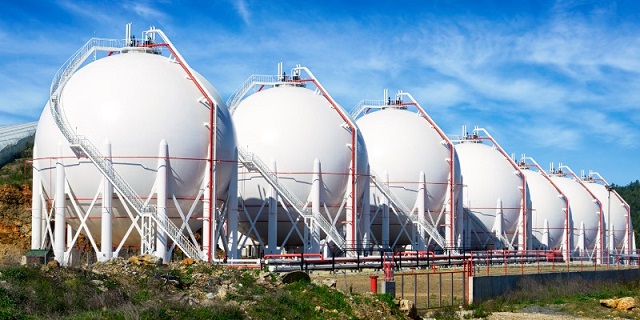Energy
Strong domestic supply chain an advantage as Canada moves ahead with new nuclear

From the MacDonald Laurier Institute
By Sasha Istvan
Canada has two major advantages. We produce uranium and we have an established supply chain.
The pledge from 22 countries, including Canada, to collectively triple nuclear capacity by 2050 drew cheers and raised eyebrows at the United Nations Climate Change Conference last fall in Dubai. Climate commitments are no stranger to bold claims. So, the question remains, can it be done?
In Canada, we are well on our way with successful and ongoing refurbishments of Ontario’s existing nuclear fleet and planning for the development of small modular reactors, or SMRs, in Ontario, New Brunswick, Saskatchewan and most recently Alberta.
The infrastructure required to generate nuclear energy is significant. You not only need engineers and technicians working at a plant, but the supply chain to support it.
Over five decades worth of nuclear generation has allowed Canada to build a world class supply chain. Thus far it has focused on servicing CANDU reactors, but now we have the potential to expand into SMRs.
I first became interested in the CANDU reactor after working as a manufacturing engineer for one of the major fuel and tooling suppliers of Ontario Power Generation and Bruce Power. I witnessed firsthand the sophistication and quality of the nuclear supply chain in Ontario, being particularly impressed by the technical expertise and skilled workers in the industry.
The CANDU reactor is the unsung hero of the Canadian energy industry: one of the world’s safest nuclear reactors, exported around the world, and producing around 60 per cent of Ontario’s electricity, as well as 40 per cent of New Brunswick’s.
Having visited machine shops across Ontario, it’s evident that Canadians should take pride that the expertise and technology required for the safe generation of nuclear energy is available here in Canada.
As Canada looks to grow its nuclear output to achieve net-zero goals, its well-established engineering and manufacturing capabilities can make it a leader in the global expansion of nuclear energy as other nations work to make their COP28 declaration a reality.
Canada has two major advantages. The first is that it is a globally significant producer of uranium. We already export uranium from our incredible reserves in northern Saskatchewan and fabricate unenriched uranium fuel for CANDU. Canadian uranium will be an important ingredient in the success and sustainability of a nuclear renaissance, especially for our allies.
The second is that we have an established and active supply chain. While new nuclear builds have slowed dramatically in the western world — a result of the fallout from Chernobyl and Fukushima, as well as competition from cheap natural gas — Bruce Power and OPG are in the midst of major refurbishments to extend their operations until 2064 and 2055, respectively.
Bruce Power has successfully completed the first unit refurbishment on schedule and within budget, with ongoing work on the second unit. OPG has accomplished refurbishments for two out of its four units at Darlington, with the latest unit completed ahead of schedule and under budget. These multibillion-dollar refurbishments have actually grown our nuclear supply chain and demonstrate that it’s firing on all cylinders.
SMRs are the next phase of nuclear technology. Their size and design make them well suited for high production and modular construction. Investing in the supply chain for SMRs now positions Canada for significant economic gains.
OPG plans to build four GE-Hitachi BWRX-300 reactors, with the first slated for service as early as 2028. This first-of-a-kind investment will help identify and overcome design challenges and develop its own supply chain. That will benefit not only their project but those that follow suit.
SaskPower is planning to proceed with the same SMR design, as well as the first pilot globally of the Westinghouse eVinci microreactor; New Brunswick is moving ahead with the ARC-100, both for its existing nuclear site at Point Lepreau as well as in the Port of Belledune; and OPG and Capital Power recently announced a partnership to explore a nuclear reactor in Alberta, including the potential for the BWRX-300.
While the bulk of the nuclear supply chain is currently located in Ontario, other provinces have already been investing in the development of local capacity.
All this activity sets Canada up to leverage first-mover advantage and become a significant global provider of BWRX-300 components. Canada will not only see the economic benefits during initial construction but also through sustained demand for replacement parts in the future.
Nuclear energy has already made a significant contribution to the Canadian economy. In 2019, a study commissioned by the Canadian Nuclear Association and the Organization of Canadian Nuclear Industries showed that the nuclear industry accounted for $17 billion of Canada’s annual GDP annually and has created over 76,000 jobs.
Notably, 89 per cent of these positions were classified as high-skilled, and over 40 per cent of the workforce was under 40. This study, conducted before the announcement of SMR plans, was followed by a more recent report from the Conference Board of Canada on the economic impact of OPG’s SMR initiatives. The study found that the construction of just four SMRs at OPG could boost the Canadian GDP by $15.3 billion (2019 dollars) over 65 years and sustain approximately 2,000 jobs annually during that period.
Public perception of nuclear is improving. In 2023, the percentage of Canadians wanting to see further development of nuclear power generation in Canada grew to 57 per cent compared with 51 per cent in 2021.
As well, the Business Council of Canada has voiced its support for nuclear expansion, emphasizing Canada’s strategic advantages: political and public backing across the spectrum, coupled with a rich history of nuclear expertise.
Nuclear energy is dispatchable, sustainable and a proven technology. As nations move to achieve their climate goals, it has one other major benefit: a supply chain that is wholly western and in Canada’s case almost totally domestic.
While the critical minerals and manufactured goods required for batteries, wind and solar energy rely heavily on China and other politically unstable or authoritarian countries, nuclear provides energy independence. Canada is well positioned to help our allies improve their energy security with our strong, competitive nuclear supply chain.
Sasha Istvan is an engineer based in Calgary, with experience in both the nuclear supply chain and the oil and gas sector.
Energy
Tech giants’ self-made AI energy crisis

For years tech giants have been helping climate catastrophists shut down reliable fossil fuel electricity. Now the grid they’ve helped gut cannot possibly supply their growing AI needs.
|
|
For years tech giants have been helping climate catastrophists shut down reliable fossil fuel electricity, falsely claiming they can be replaced by solar/wind.
Now the grid they’ve helped gut can’t supply their growing AI needs.¹
- For the last decade, tech giants such as Apple, Microsoft, Meta, and Google have, through dedicated anti-fossil-fuel propaganda and political efforts, promoted the shutdown of reliable fossil fuel power plants in favor of unreliable solar and wind.
- Tech giants have propagandized against reliable fossil fuel power plants by falsely claiming to be “100% renewable” and implying everyone could do it. In fact, they have just paid utilities to credit them for others’ solar and wind use and blame others for their coal and gas use.²
- In addition to their “100% renewable” propaganda, tech giants directly endorsed people and policies who shut down reliable fossil fuel power plants.E.g., The RE100 coalition, including Google, Apple, Meta, and Microsoft, advocates for policies to “accelerate change towards zero carbon grids at scale by 2040.”³
- Companies’ propaganda that solar/wind could rapidly replace fossil fuels has proven false.
Statewide blackouts in California (2020) and Texas (2021) were caused by the failure of solar/wind—which can go near zero at any time—to make up for lack of reliable fossil fuel capacity.
- Thanks in significant part to tech giants’ advocacy, we have now shut down enough reliable power plants to be in a nationwide electricity crisis.
For example, most of North America is at elevated/high risk of electricity shortfalls between 2024-2028.⁴
- The anti-fossil-fuel, pro-unreliable solar and wind political climate that tech giants have fostered is getting much worse, as the Administration has pledged to further reduce reliable electricity supply via power plant shutdowns and add artificial demand through EV mandates.
Biden’s EV mandate: a dictatorial attack on the American driver and the US grid
·APR 22Biden’s de facto mandate of over 50% EVs by 2032 is a dictatorial attack on the American driver and the US grid that will 1. Force Americans to drive inferior cars. 2. Place massive new demand for reliable electricity on a grid that is declining in reliable electricity supply.
Read full story - While for years tech giants didn’t seem to have any concern about the electricity supply disaster their propaganda and policies were bringing about, they are now very interested because of the accelerating power requirements of computing, above all the hyper-competitive AI space.
- To function at its potential, AI requires massive amounts of power. E.g., state-of-the-art data centers can require as much electricity as a large nuclear reactor.⁵
- Electricity demand from US data centers already doubled between 2014 and 2023. Now with the fast growth of energy-hungry AI, demand from data centers could triple from 2.5% to 7.5% of our electricity use by 2030, according to Boston Consulting Group.⁶
- In large part due to AI, nationwide electricity demand is projected to skyrocket. Official 10-year projections for the US have summer and winter peak demand rising by over 79 gigawatt and over 90 gigawatt. 90 gigawatt is equivalent to adding the entire power generating capacity of California (!)⁷
- Given the woeful underpowered grid that AI giants have helped bring about, dramatically rising demand from AI will not only contribute to massive electricity shortages, but it will also destroy a lot of potential for AI to occur in the United States.
- Limited and expensive electricity will force data centers to operate with higher cost or lower capacity within the US—or take a performance hit in the form of increased latency (which can drastically reduce the value of the product) by moving offshore.
- Not only is offshoring data centers destructive from an economic standpoint, it also poses a substantial security risk. E.g., Building a data center in China—which we already depend on dangerously for critical minerals—gives the CCP physical power over more parts of our economy.
- Economically, data centers are a gold mine of opportunities.Globally, data centers employed 2M people full-time in 2019, many in high-skill/high-pay jobs—and this number is forecast to increase nearly 300K by 2025.
Our gutted grid will cost many Americans these opportunities.⁸
- In the face of woefully inadequate electricity supply for their AI goals, tech giant CEOs are finally speaking up about the lack of power.
E.g., Meta CEO Mark Zuckerberg said in an interview that energy will be the #1 bottleneck to AI progress.
- It is not enough for tech giants to warn us about the lack of reliable power. They need to take responsibility for their anti-fossil-fuel advocacy that helped caused it. And they need to support energy freedom policies that allow all fuels to compete to provide reliable power.
End preferences for unreliable electricity
·DECEMBER 14, 2022Today’s grids are being ruined by systemic preferences for unreliable electricity: 1) no price penalty for being unreliable 2) huge subsidies for unreliables 3) mandates for unreliables Congress should end these now. The Opportunity America, given its combination of abundant domestic energy resources, technological ingenuity, and free-market competition, has …
Read full story - An example of a tech giant influencer not taking any responsibility for causing the electricity crisis is BlackRock CEO Larry Fink, who pushed companies and governments to adopt “net-zero” policies using mostly solar/wind, but now admits they can’t power AI data centers!
- A better attitude toward electricity was expressed by OpenAI CEO Sam Altman: “There will always be people who wait and sit around and say ‘we shouldn’t do AI because we may burn a little more carbon’… the anti-progress streak” and this “is something that we can all fight against.”⁹
- America faces a choice. We can either continue our current trajectory, descend into a Third World grid, and become totally inhospitable for AI, or we can adopt energy freedom policies and become a world leader in both AI and electricity.
- Share this article with tech giant CEOs and tell them to publicly apologize for damaging our grid and to commit to energy freedom policies.Google: @sundarpichai ([email protected])
Apple: @tim_cook ([email protected])
Meta: @finkd ([email protected])
Microsoft: @satyanadella ([email protected])
Michelle Hung contributed to this piece.
Popular links
- EnergyTalkingPoints.com: Hundreds of concise, powerful, well-referenced talking points on energy, environmental, and climate issues.
- My new book Fossil Future: Why Global Human Flourishing Requires More Oil, Coal, and Natural Gas—Not Less.
- Speaking and media inquiries
“Energy Talking Points by Alex Epstein” is my free Substack newsletter designed to give as many people as possible access to concise, powerful, well-referenced talking points on the latest energy, environmental, and climate issues from a pro-human, pro-energy perspective.
Energy
New Report Reveals Just How Energy Rich America Really Is

 From the Daily Caller News Foundation
From the Daily Caller News Foundation
A new report by the Institute for Energy Research (IER), a nonprofit dedicated to the study of the impact of government regulation on global energy resources, finds that U.S. inventories of oil and natural gas have experienced stunning growth since 2011.
The same report, the North American Energy Inventory 2024, finds the United States also leading the world in coal resources, with total proven resources that are more than 53% bigger than China’s.
Despite years of record production levels and almost a decade of curtailed investment in the finding and development of new reserves forced by government regulation and discrimination by ESG-focused investment houses, America’s technically recoverable resource in oil grew by 15% from 2011 to 2024. Now standing at 1.66 trillion barrels, the U.S. resource is 5.6 times the proved reserves held by Saudi Arabia.
The story for natural gas is even more amazing: IER finds the technically recoverable resource for gas expanded by 47% in just 13 years, to a total of 4.03 quadrillion cubic feet. At current US consumption rates, that’s enough gas to supply the country’s needs for 130 years.
“The 2024 North American Energy Inventory makes it clear that we have ample reserves of oil, natural gas, and coal that will sustain us for generations,” Tom Pyle, President at IER, said in a release. “Technological advancements in the production process, along with our unique system of private ownership, have propelled the U.S. to global leadership in oil and natural gas production, fostering economic benefits like lower energy prices, job growth, enhanced national security, and an improved environment.”
It is key to understand here that the “technically recoverable” resource measure used in financial reporting is designed solely to create a point-in-time estimate of the amount of oil and gas in place underground that can be produced with current technology. Because technology advances in the oil and gas business every day, just as it does in society at large, this measure almost always is a vast understatement of the amount of resource that will ultimately be produced.
The Permian Basin has provided a great example of this phenomenon. Just over the past decade, the deployment of steadily advancing drilling and hydraulic fracturing technologies has enabled producers in that vast resource play to more than double expected recoveries from each new well drilled. Similar advances have been experienced in the other major shale plays throughout North America. As a result, the U.S. industry has been able to consistently raise record overall production levels of both oil and gas despite an active rig count that has fallen by over 30% since January 2023.
In its report, IER notes this aspect of the industry by pointing out that, while the technically recoverable resource for U.S. natural gas sits at an impressive 4.03 quads, the total gas resource in place underground is currently estimated at an overwhelming 65 quads. If just half of that resource in place eventually becomes recoverable thanks to advancing technology over the coming decades, that would mean the United States will enjoy more than 1,000 years of gas supply at current consumption levels. That is not a typo.
Where coal is concerned, IER finds the US is home to a world-leading 470 billion short tons of the most energy-dense fossil fuel in place. That equates to 912 years of supply at current consumption rates.
No other country on Earth can come close to rivaling the U.S. for this level of wealth in energy mineral resources, and few countries’ governments would dream of squandering them in pursuit of a political agenda driven by climate fearmongering. “And yet, many politicians, government agents, and activists seek to constrain North America’s energy potential,” Pyle says, adding, “We must resist these efforts and commit ourselves to unlocking these resources so that American families can continue to enjoy the real and meaningful benefits our energy production offers.”
With President Joe Biden and former President Donald Trump staking out polar opposite positions on this crucial question, America’s energy future is truly on the ballot this November.
David Blackmon is an energy writer and consultant based in Texas. He spent 40 years in the oil and gas business, where he specialized in public policy and communications.
-

 Addictions2 days ago
Addictions2 days agoLiberals shut down motion to disclose pharma payments for Trudeau’s ‘safe supply’ drug program
-

 espionage1 day ago
espionage1 day agoThe Scientists Who Came in From the Cold: Canada’s National Microbiology Laboratory Scandal, Part I
-

 Energy1 day ago
Energy1 day agoTech giants’ self-made AI energy crisis
-

 National1 day ago
National1 day agoTrudeau’s internet censorship Bill C-11 will not be implemented until late 2025
-

 Frontier Centre for Public Policy1 day ago
Frontier Centre for Public Policy1 day agoThe PM as Leaf’s coach
-

 Economy13 hours ago
Economy13 hours agoPrime minister’s misleading capital gains video misses the point
-

 COVID-1914 hours ago
COVID-1914 hours agoTucker Carlson and NFL star Aaron Rodgers discuss Bill Gates, COVID-19, US Deep State





















